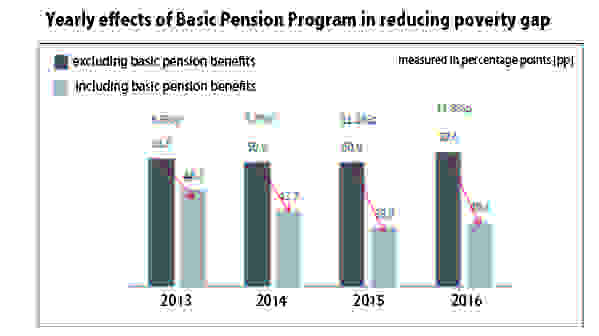 |
|
Yearly effects of Basic Pension Program in reducing poverty gap (measured in percentage points [pp])
|
Poverty gap ratio decreases by significant percentage points
According to a new report, the degree of poverty faced by poor elderly individuals in South Korea has been mitigated by the government’s adoption of the basic pension program. This program is designed to guarantee income for the elderly by paying pension to individuals at least 65 years old who are in the lower 70% income bracket. The program was implemented in July 2014, building upon a previous program called the basic old-age pension. As of this April, single-person households were eligible to receive up to 209,960 (around US$195) won each month in basic pension benefits. On May 2, the National Pension Research Institute released a report by Choi Geum-ok and Lee Eun-yeong titled “Fact-Finding Analysis of Elderly Poverty Before and After the Introduction of Basic Pension.” According to this report, which analyzed yearly data from surveys of household trends by Statistics Korea conducted between 2013 and 2016, the basic pension’s effectiveness at reducing the poverty gap for the elderly poor has steadily increased since the program’s introduction. The poverty gap is an index that measures the distance between the poverty line, or the level of income capable of sustaining a minimum lifestyle, and poor households’ actual income. A higher poverty gap ratio means a greater degree of impoverishment. When the basic pension program was introduced in 2014, elderly households faced a poverty gap ratio of 42.7%. That figure was 8.2 percentage points lower than the 50.9% that results when basic pension is left out of the equation, which reflects how much of an impact basic pension had on shrinking the poverty gap ratio. In 2015, there was a poverty gap ratio of 39.8%, which was 11.1 points lower than the 50.9% poverty gap found by subtracting basic pension benefits. In 2016, the poverty gap ratio was 40.8%, which would be 52.6%, or 11.8 points higher, if not for basic pension. In other words, the report explained, the basic pension’s mitigation of the poverty gap ratio increased from 8.2 points in 2014 to 11.1 points in 2015 and then to 11.8 points in 2016. On the other hand, the relative poverty rate among the elderly fell from 47.2% in 2014 to 44.7% in 2015 before increasing to 46.7% in 2016. The absolute poverty rate showed a similar trend: 33.2% in 2014, 28.8% in 2015 and 33.1% in 2016. The relative poverty rate is the percentage of elderly people whose income level is below 50% of the median income, while the absolute poverty rate is the percentage whose income is below the minimum cost of living. The basic pension’s mitigation effect on relative and absolute poverty also increased until 2015 before decreasing slightly in 2016. “Since basic pension has a universal characteristic, applying to 70% of the elderly, and since pension benefits do not vary much with income, this system is more effective at reducing the poverty gap than the poverty rate. The fact that basic income’s effectiveness at mitigating the poverty rate and the poverty gap ratio is decreasing suggests the need to consider policy measures such as increasing the amount of benefits in the future,” the researchers wrote in the report. By Park Hyun-jung, staff reporter Please direct comments or questions to [english@hani.co.kr]






